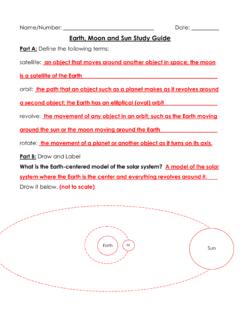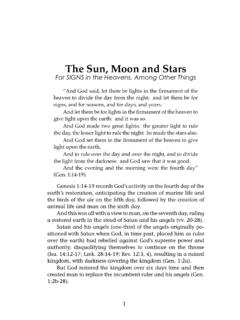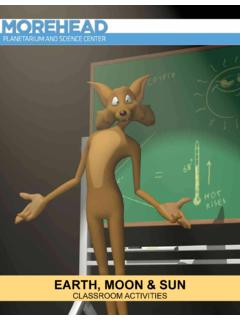Transcription of Earth, Sun, and Moon - Be Awesome At Pattison
1 1 earth , Sun, and moon The Sun and moon are earth s constant companions. We bask in the Sun s heat and light. It provides earth s energy, and life could not exist without it. We rely on the moon to light dark nights. earth s closest neighbor, the moon , is the only other object in space on which humans set foot. Together, the Sun, earth , and moon are responsible for ocean tides, eclipses, and the phases of the moon . But, they couldn t be more different when it comes to size and structure. How do the characteristics of the earth , Sun, and moon compare to one another? What are the physical characteristics of the Sun? The Sun is a star at the center of our solar system. This means that the Sun is more similar to other stars than to earth or the moon .
2 The Sun seems larger and brighter than other stars because it is so close to earth . Here are some other physical characteristics of the Sun. Surface: The Sun, like all stars, is a glowing ball of gas. Even if a spaceship could withstand the heat, it could not land on the Sun because the Sun s surface is not solid. Atmosphere: Because the Sun is made up of gas, it has a very thick atmosphere. An atmosphere is a layer of gases surrounding an object in space. The majority of the gas that makes up the Sun is hydrogen. The gases in the Sun are packed tightly together, making it incredibly dense. This contributes to the Sun s very strong gravity. Temperature: Different parts of the Sun have different temperatures. The surface The surface is one of the coolest areas of the Sun at 5,500 C (10,000 F).
3 But, that s nothing compared to the core, or center. The average temperature at the center of the Sun is 15,000,000 C (27,000,000 F)! A solar flare erupts from the surface of the Sun. A picture of earth is added to show the enormous size of the flare. gravity: an attractive force between all objects with mass 2 earth , Sun, and moon Features: Sunspots and solar flares are features on the Sun s surface. They are dark areas that are cooler than the rest of the Sun s surface. The number of sunspots changes about every 11 years. Solar flares are quick increases in brightness. They occur when energy builds up in the Sun and is suddenly released. Solar flares extend beyond the surface of the Sun and look like explosions. Size: The Sun has much more mass than any of the other objects in the Solar System.
4 In fact, about one million Earths could fit inside the Sun! Its great mass gives the Sun very strong gravity. earth and the other objects in the Solar System follow continuous orbits around the Sun because its gravity is so great. The Sun is so hot that it glows. However, the Sun is not on fire. Fire is a reaction that occurs on earth when a fuel, like wood or oil, mixes with oxygen and a spark. The Sun contains no such fuel for fires. Instead, in the core of the Sun hydrogen particles come together to form helium particles. This reaction produces huge amounts of energy. This is what makes the Sun hot and causes it to glow. In this way, sunlight is more similar to a light bulb than to a flame. A tiny piece of metal inside a light bulb is heated using electricity.
5 It becomes so hot that it begins to glow with a bright light. The Sun s glow works in a similar way. However, instead of electricity it uses energy from the reactions in its core. What are the physical characteristics of earth ? Our home planet is just one of the bodies that orbits the Sun. It shares many characteristics with other planets and moons in the solar system. However, it is unique in one special way there is life on earth . Life has not yet been discovered anywhere else in the universe. However, scientists have hypothesized that it is possible, given the number of stars and planets out in space. Many of the physical features on earth have made it an ideal place for life to develop. mass: the amount of matter in an object orbit: a curved path around an object, such as the Sun 3 earth , Sun, and moon atmosphere also contains oxygen.
6 Oxygen is necessary for many living things including humans to breathe. Temperature: earth is the third planet from the Sun. This is the perfect distance for life our planet never gets extremely hot or extremely cold. Even the coldest and hottest places on earth are not extreme compared to other planets. The average temperature on earth is 15 C (59 F). For comparison, the average temperatures of earth s closest neighboring planets are 461 C (861 F) on Venus and 63 C ( 81 F) on Mars! Features: earth has many features, including mountains, volcanoes, forests, and continents. One of earth s most important features, however, is the presence of liquid water. Approximately 70% of the planet is covered in oceans, but there is still more water held in lakes, rivers, icebergs, and glaciers.
7 Even the atmosphere contains water in clouds and vapor, which is the gas form of water. The presence of water on earth makes life possible on earth . Surface: Unlike the Sun, the surface of earth is solid. Even below the liquid oceans, there is solid earth . Because of this, earth is called a rocky planet. However, the planet is not completely solid. Part of earth s core is a liquid mix of metals mostly iron and nickel. Atmosphere: earth is surrounded by an atmosphere of gases. We know it better as air. The atmosphere is an important reason why life exists on earth . It holds in much of the heat from the Sun so the planet never gets too cold. The Size: The rocky planets in the solar system are much smaller than the gas giant planets like Jupiter and Saturn.
8 earth is the largest of the rocky planets. However, it is still very, very small in comparison to the Sun. It would take 100 Earths lined up next to each other to equal the Sun s diameter. Other than earth , scientists have not found any other places in the universe that have liquid water and life. glaciers: slow moving masses of ice and snow that have accumulated over time diameter: the distance between two opposite points on a sphere 4 earth , Sun, and moon Surface: Like earth , the moon is rocky. The moon has no active volcanoes; however, recent moonquake data suggests that there is magma under its surface. The moon s surface is divided into two categories, which can be seen when you look at it from earth . The light-colored areas are hills called highlands.
9 The dark-colored areas are called maria (singular: mare). They are flat plains that early astronomers incorrectly thought were seas. (Maria is the Latin word for seas. ) Most of the moon s surface is covered with craters, rocks, and dust. Craters are holes or pits on the surface formed when chunks of space rock crash into the moon . Atmosphere: The reason that the moon is struck by objects from space all the time is because it has no atmosphere. The layer of gas surrounding earth protects it from incoming meteoroids, most of which burn up in our atmosphere. The moon has no such protection from collisions. Temperature: The lack of an atmosphere causes the moon to have extreme temperatures. An atmosphere acts like a blanket around a planet.
10 At night, it holds in some of the heat. On the moon , nearly all the energy from the Sun is reflected back to space. Temperatures during the day can be as high as 123 C (253 F), but at night they drop to 233 C ( 387 F). What are the physical characteristics of earth s moon ? Coming into view each night in earth s sky is the moon . As earth orbits the Sun, the moon orbits earth . The moon is the only other object in outer space that humans have ever visited. When astronauts first landed on the moon in 1969, they discovered some of its physical characteristics for the first time. Features: There are very few features on the moon besides the craters. It is dusty, rocky, and lifeless. Because there are no active volcanoes, flowing rivers, rainfall, or winds, the moon rarely changes.









